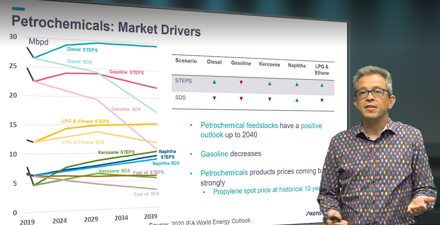Axens opens IRPC Operations with Innovation Showcase
Lee Nichols, Editor-in-Chief/Associate Publisher, Hydrocarbon Processing
Hydrocarbon Processing’s International Refining and Petrochemicals Conference (IRPC) opened with the Innovations Showcase, hosted by Axens. IRPC Operations technical conference highlights the latest equipment, services, tools and technologies to optimize refining and petrochemical operations and maintenance efforts for a safer, more efficient, more profitable and sustainable work environment. The Innovations Showcase highlighted trends and several technologies that are shaping hydrocarbon processing industries.
IRPC Operations’ Innovation Showcase began with a detailed analysis of the global refining industry by Olivier le Coz, Technology Director, Axens. His presentation examined how the refining industry has changed since the COVID-19 global pandemic. Several major trends have transpired, including deep company reorganizations, the restoration of refining margins as crude oil prices increase and refiners’ investments in adding value to their operations to improve competitiveness (FIG. 1). Areas of future competitiveness include renewables (e.g., lipids hydroprocessing to produce renewable diesel and sustainable aviation fuel, processing alcohols into gasoline and jet fuel, using cellulosic biomass as a feed source), plastics recycling (i.e., the circular economy) and incorporating petrochemicals into existing assets.

FIG. 1. Oliver le Coz provided several trends that have transpired since the global pandemic.
Mr. le Coz’s presentation was followed by Nevin Whalley, Technology Solutions Engineer, Axens. His presentation, “Extending cycle length for coker naphta hydrotreaters,” focused on three key factors to successfully overcome common issues that limit cycle length:
- Pressure drop
- Poisons (e.g., silicon and arsenic)
- Catalyst activity.
Mr. Whalley detailed several solutions to help owner-operators diagnose unit challenges, along with several options to help optimize operations. These include:
- Using Axens’ Hy-Ring® solution to limit pressure drop
- Utilizing Axens’ SiTrap® and ArsenicTrap™ to limit silicon and arsenic contamination
- Using Axens’ wide portfolio of hydrotreating catalysts (i.e. Axens’ Impulse™ catalyst family).
These solutions were followed by case studies to show how implementing these technologies increased operational efficiency.
Juan Pereira de la Riera, Technologist, Axens, provided a detailed examination of Axens’ Prime G+ technology and how it can mitigate CO2 emissions, while maintaining or increasing operational profitability.
Michael Craig, Chief Technology Engineer, Axens, focused on the specifics of Axens’ hydrocracking technology. His presentation started with an overview of the catalyst technology for each section of the hydrocracker—pretreating and cracking (e.g., Impulse™ catalyst series and Craken™ catalyst series), followed by two case studies demonstrating catalyst performance in industrial operating units—an Axens’ designed two-stage hydrocracker located in China and a once-through, high-conversion hydrocracker located in Europe (FIG. 2)—and concluded with Axens’ pilot testing capabilities and experience.

FIG. 2. Michael Craig details a case study on Axens' Craken-Flex series used in a hydrocracker in Europe.
Nandita Akunuri, Senior Advanced Applications Engineer, Axens, provided a detailed overview of Axens’ Connect’In™ for process monitoring (FIG. 3). According to Ms. Akunuri, most digital solutions now are built around internal applications such as predictive maintenance, safe and reliable operations, plant optimization, and supply chain. However, there is additional value to capture. This includes developing digital ecosystems to provide refiners access to capabilities and domain expertise to obtain additional value from their assets. This is where Connect’In™ comes in. The technology provides real-time unit monitoring and advanced modeling to provide operations with predictive tools, benchmarking and the data needed to accelerate the decision-making process for optimal unit management.

FIG. 3. Nandita Akunuri details the benefits of Axens' Connect'In technology.
The final presentation, “Expanding the ethanol value chain,” was presented by David Schwalje, Renewables Business Development Manager, Axens. The presentation detailed commercial pathways to renewable chemicals and drop-in liquid fuels. These include Axens’ technologies such as Vegan®, BioTfueL®, BioTCat™, Atol® and Futurol™.
IRPC Operations continues through Wednesday. The global, virtual event is free to attend; however, you must register. To register, view the agenda and access more information about the event, please go to the IRPC Operations home page.






Comments